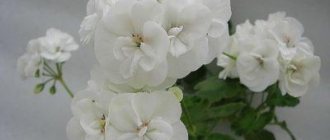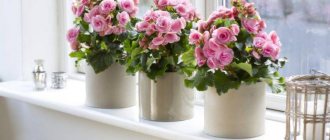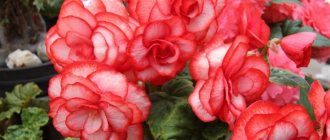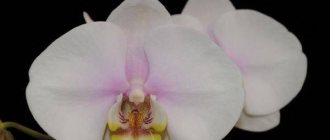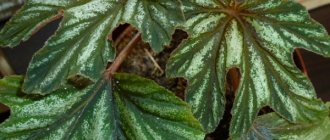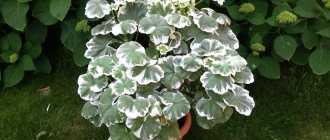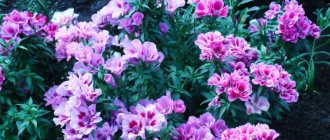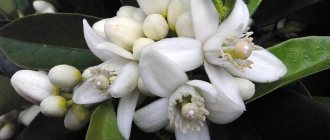Yandex.RTB RA-1479455-2
The most unpretentious begonias are root begonias. They do not need to have a rest period like tubers. However, the roots require care all year round. They are fed in winter, but less often than in summer; they are pruned in spring. Regardless of the type, all begonias grow well and delight with their decorative properties in high humidity in combination with unsalted soil. In this regard, there are nuances of watering: as the soil dries out, only in the tray you can avoid spraying the leaves. How to properly care for a flower so that it is as beautiful as in the photo of this article?
Origin of begonia and distinctive features
There are more than 1 thousand species of begonias in nature. The largest number of varieties is found in South America, followed by Asia (India, the Himalayas, Sri Lanka), and western Africa in third place. There is an assumption that Africa is the birthplace of begonias, from here they spread to Asia and America. In the wild, plants are found in humid subtropics and mountains.
Deciduous begonias
Yandex.RTB RA-1479455-7
The family was first described by the French botanist Charles Plumier. In 1683, under the leadership of the intendant of the French colonies, Michel Begon, he visited the islands of the Caribbean with an expedition. There the scientist discovered plants that were unknown at that time, gave them a description and named them after the organizer of the trip.
The begonias known today differ greatly from each other in size, shape, coloring of leaves and flowers. Some are perennial, others are annual. There are herbaceous and shrubby begonias, with creeping or thickened rhizomes. But there is also something in common that unites these plants into one family.
Characteristics of begonias:
- All types of begonias have an asymmetrical, oblique leaf;
- flowers are monoecious;
- perianths - brightly colored, unequal;
- the fruit with seeds looks like a capsule;
- all begonias grow in approximately the same natural conditions: diffused sunlight, high humidity, temperature +13... +22 °C.
Video: the wealth of types and colors of a flower
Tuberous begonia has gained the greatest popularity among gardeners. In beauty and abundance of flowers, begonias are second only to roses. The plant has a fairly long flowering interval: in open ground it lasts more than four months (from June to September), at home it can last up to six months or more. The plant does not like windy areas and direct sunlight.
No worse than roses
Yandex.RTB RA-1479455-3
The size of begonia flowers is very diverse: there are varieties with flowers up to 20-25 cm in diameter, however, most have smaller flowers, which compensate for this deficiency with a large number of flowers in inflorescences.
A variety with a large number of flowers in inflorescences
Yandex.RTB RA-1479455-8
The shape of the flower is also very diverse. A separate group includes ampelous begonias, which have a characteristic inflorescence shape and long branching shoots. There are also ever-flowering begonias, which are unique flowering record holders - it lasts up to 8 months for these plants.
Ampel beauty
The main difference between club begonia is the presence of a large rhizome, from which fairly thick stems with heart-shaped leaves grow. The stems are covered with fluffy petals.
Tuberous
Varieties and types of beautiful flowering begonias
When it comes to the species and varietal diversity of beautifully flowering begonias, you should prepare for uncertainty and confusion. The thing is that all modern begonias with beautiful flowering are hybrids. And even if we are talking about a specific variety, it is still represented on sale by varieties that have undergone a long and complex selection.
When choosing beautifully flowering begonias, it is not necessary to strictly follow the botanical name of the plants, because often the same varieties are named differently in different catalogs. The main thing is the decorativeness of the plant. Begonias are chosen with the heart and eyes, according to your taste and to suit your interior.
The possibilities for choosing flowering begonias are not limited by any parameter. Only in terms of the color palette, they range from the brightest to the lightest and most unusual variations of white, yellow, pink, orange, red, purple colors, not to mention a variety of watercolor and contrasting two-color combinations, further expanding the color palette of beautifully flowering begonias.
Begonia cucullata
The most popular varieties of beautifully flowering begonias
Varieties of ever-flowering or ever-flowering begonia (today given the specific name Begonia cucullata, but until now it is better known as Begonia semperflorens) are a hybrid species of begonia, which were obtained by crossing more than 5 different Latin American varieties of begonias. These are subshrubs with simple ovate, dark red or green, glossy leaves located alternately on succulent shoots. Each plant displays loose inflorescences of white, pink or red flowers appearing on long stalks from the axils of the leaves.
Flowers can be double or simple. The ever-blooming begonia blooms constantly and tirelessly. The visible differences make it easy to distinguish plants with male four-petaled flowers from those with female five-petaled flowers. This begonia has a huge number of varieties and series of varieties - from small-growing (up to 20 cm) 'Cocktail', 'Eureka', 'Olimpia', 'Queen' to medium-growing (about 25 cm) 'Ambassador', 'Vision', 'Victory' ' up to half-meter-long begonias of the 'Stara', 'Lotto', 'Baby Wing Pink', 'Inferno' series.
Hybrids of the 'Elatior' group (they are mistakenly associated with high begonia, a species plant that most often continues to be distributed under the botanical name Begonia elatior, although according to recent data it has been reclassified as the species Begonia reniformis; here it is more appropriate to talk about a separate group of varieties, rather than hybrids of the same plant - Begonia x hybrida 'Elatior').
Due to their popularity, the varieties are due to their larger flowers, reminiscent of anemones and roses, an abundance of colors and the ability to bloom in winter or almost tirelessly (in some catalogs they are even advertised as blooming all year round, although they still need a dormant period). "Elatior" is grown both indoors and in garden culture. The plants form lush compact bushes with bright flowers that densely cover the entire bush.
Begonias of the 'Lorraine' group are winter-flowering varieties of begonias that are one of the most striking decorations of the winter interior. The color palette of these begonias is limited only to white and pink shades, but the bushes resemble blooming clouds.
Begonias of the group 'Belleconia', 'Pendula' and other ampelous begonias are ampelous plants with luxurious watercolor double flowers that appear to be drooping roses. Clusters of drooping flowers are combined with an interesting pattern of drooping shoots.
(Begonia x tuberhybrida) can be grown as a beautifully flowering plant indoors . These plants, familiar mainly from potted and container garden culture, are capable of blooming in open soil.
Tuberous begonias thrive in the same conditions as traditional indoor flowering begonias. After flowering, the above-ground part dies off completely, and the tubers are kept in almost dry, cool conditions (12-15 degrees) for about three months, after which they are replanted and returned to the usual environment to stimulate flowering, carefully resuming watering and fertilizing.
Begonia beautifully flowering cascade
Features of early planting
Begonia is quite easy to breed, but there are a number of rules, failure to comply with which can lead to the death of the plant. One of them is the conditions under which the tubers are kept.
Even short-term hypothermia below +5°C can cause the top of the tuber to die, so its transportation and storage must take this circumstance into account.
The begonia tuber has a pronounced asymmetry: one of its sides is convex, the other is concave. Planting in the ground is allowed only with the convex side.
Preliminary germination of tubers should be carried out from February to the end of April. In this case, it is best to plant the tubers in separate small pots filled with peat substrate; Before planting, it is recommended to slightly moisten the peat. Having soil so rich in nutrients, the begonia will quickly develop and begin to form healthy leaves.
Planting should be done at room temperature. Immediately after this, the tuber should be watered moderately. Stagnation of water during further cultivation should not be allowed, however, the soil should not be allowed to dry out.
Tuber planted in peat substrate
Diseases of tuberous begonia
Feeling unwell, the plant may shed leaves and even set buds. What could this be causing? What diseases is begonia susceptible to?
Gray rot is a fungus (genus botrytis) that affects the entire flower, causing the death of plant tissue. When it's warm and humid outside, fungal spores are instantly transported by wind and precipitation, infecting plants.
A diseased plant can easily be seen on its leaves, flowers, and the tops of the plant; a gray coating and spots form. All this soon becomes damp rot. The leaf part turns black, the stems of the plant rot and break, and the unopened buds become covered with mucus. When there is a drought outside, the rotten spots dry out, darken and form holes in the tissues of the flower.
You can fight the disease by removing the affected areas and applying a solution of 1% Bordeaux mixture before and after the begonia blooms. In home and greenhouse conditions, moderation of watering, a constant flow of fresh air and maintaining a comfortable temperature for the plant will be useful.
Powdery mildew appears as white spots on the leaves, spreads to the entire individual, causing the leaves to turn brown and become brittle. Measures to combat the disease: pollination with ground sulfur or spraying with copper-soap liquid (tar soap and copper sulfate in a ratio of 10 to 1 are mixed per liter of liquid).
Bacterial spot is another disease that affects begonias. The first symptoms: the appearance of watery spots on the underside of the leaf. Then they darken and turn black along with the flowers and flower stems.
Measures to combat the disease: it is recommended to spray with a suspension of oxychloride in a 0.5% solution once every twelve to fourteen days. Diseased garden flowers are eliminated and the soil is disinfected.
Ring spot, a disease caused by a tomato virus, manifests itself as yellow-green spots, necrosis of plant tissue and imparting a brownish-bronze hue to parts of the plant. There are no effective methods of control. It is recommended to destroy infected plants or isolate them from healthy ones.
Begonia transplant
As soon as the begonia sprouts reach a height of 5-6 cm, the plant must be transplanted into a larger pot. The minimum diameter of a pot for begonia at home should be at least 25 cm. Begonia tolerates replanting well, so at this stage there should not be any special problems.
A larger pot will allow the plant to begin its growing season in full: during the second month, the begonia will produce a large number of new leaves, and the first ovaries of flower buds will appear. Further transplants should be made in two cases: either when the root system of the begonia grows too much, or if it is necessary to plant the plant in open ground. This should be done as soon as weather conditions allow (temperature 15-20 °C).
Plants in need of replanting
The procedure for replanting a plant with a formed root system is somewhat more complicated: the flower must be completely removed from the pot and the roots must be cleared of soil. After this, they are treated with a solution of potassium permanganate by immersing them in a weak (0.1 g per 1 liter of water) solution. The residence time in the solution is no more than half an hour.
After disinfection of the plant, rotten and dried roots are cut off, and the cut areas are treated with charcoal powder. At the bottom of the pot you need to put drainage made of small crushed stone or large eggshells. The first two weeks after transplantation, the plant must be kept in the shade and provided with abundant watering.
Begonia transplant process
Features of transplanting into open ground
The place where begonias are planted must meet certain requirements: it must be an area protected from winds and direct sunlight. The ideal option is a semi-shaded area on the north side of the garden.
The planting rule is very simple - it is necessary to place begonia bushes at a distance of at least 30 cm from each other. Since the plant is decorative, it can be used for planting entire flower beds. The height of begonia reaches 35 cm, that is, this plant occupies a mid-level niche in flower beds.
After planting, it is recommended to mulch the soil with sawdust or small light stones (for example, expanded clay). Mulching helps the soil retain moisture longer and relieves the owner of the need to loosen the soil.
Flowerbed with perimeter of begonias
Ampel for home and office decoration
For home decor, small species of hanging begonia are used. They are planted in flowerpots or other hanging flowerpots so that the soft hanging stems with elegant tassels rise above the head and receive maximum light directly from above.
These representatives of the flora world bloom profusely. The root system is usually represented by a tuber , which increases in size throughout its life.
Lighting for begonias
Begonia prefers to grow in shaded areas or in areas where there is indirect sunlight. Contact with direct rays of the sun is unacceptable.
Begonia also does not tolerate changes in light: if the germination of the tuber and the beginning of the plant's growing season took place under the same lighting conditions, then when they change, the plant may begin to wither. In the house, the optimal location for the flower will be all well-lit window sills, except the southern one.
On the north side of the house in a warm climate
On southern window sills, if specialized shading or light diffusion measures are not applied, burns may appear on the leaves.
On a shaded windowsill
Secrets of keeping indoor begonias
Of course, begonia is an exotic, exquisite representative of the flora, but it is not difficult to care for, is unpretentious for home cultivation, and easily adapts to almost any conditions.
Pots with begonia feel great on the windowsill even on the south side, although the exception is hot summer. Some gardeners compensate for the lack of natural light with special fluorescent phytolamps, which are advisable to use in the autumn-winter period.
For abundant flowering and normal growth, plants need 18-20 degrees of heat. At temperatures below +5, a representative of the flora quickly dies. Optimal humidity levels are 50%. It is strictly forbidden to place flowerpots with begonia of any kind near heating radiators and gas stoves.
It is difficult to imagine a modern home or office without living plants. Blooming, decorative leafy begonias will complement the interior, making it complete and original. Choosing the right plant variety for a given space can be problematic. Use the articles on the site, look at the photographs, learn more about growing and propagation to form your own amazing collection.
Plant care
Begonia feels good at temperatures from 18 °C to 22 °C. Seedlings require higher temperatures - from 20 ° C to 25 ° C. The soil should be neutral or acidic.
The temperature in the room with indoor begonias should not fall below +18 ° C, and the soil should not be alkaline.
Before transplanting into stationary pots, begonia seedlings require fertilizing once every two weeks with complex fertilizers. You can prepare them yourself from a mixture of nitrogen and potassium fertilizers, but it is better to purchase special fertilizers for violets and begonias, sold at any flower shop.
An adult plant is fertilized twice:
- nitrogenous fertilizers during the active growing season
- a mixture of phosphorus and potassium fertilizers before flowering
It is best to apply fertilizers in the evening, and two hours before applying them, the soil should be slightly moistened. After applying fertilizers, the plant is also lightly watered.
After flowering ends (as a rule, this occurs in late autumn), indoor begonias need light feeding with potassium fertilizers.
During flowering, the plant requires supports for the stems on which the flowers are located. This is due to the large number of flowers in the inflorescences or the relatively large mass of the flower compared to the stem.
With the onset of cold weather, garden begonias should dig up the tubers, clean and wash them, and then dry them for about a week in a cool, shaded room. Before drying, it is necessary to cut the stem no less than 3 cm from the tuber. After which the tubers are stored until February at temperatures of at least +5 °C. Once a month, the substrate on which stored begonias lie must be moistened.
Storing the tuber for storage
Tuberous: features, characteristics
This variant of representatives of the world of flora assumes the presence of a perennial tuber that constantly grows and stores nutrients.
Tuberous begonia has chic decorative properties; it can bloom continuously for 5-6 months , which makes it in demand when decorating the designs of residential and non-residential interiors.
Many florist experts claim that begonia is not inferior in beauty to such popular flowering plants as roses and dahlias. The most in demand are hybrid varieties with large double flowers and a bright border around the edges.
Features of watering
To maintain the plant in good condition, it must be properly watered. Begonia at home requires special attention. In the summer, drying out is not acceptable for a plant with massive stems and leaves.
In normal temperature ranges, begonias need to be watered once every 2-3 days, however, in hot weather, watering should be done every day. This is especially important during the flowering period.
The soil should be well moistened, however, there should be no stagnation of water. In this regard, pot drainage plays a significant role. It should reach about a quarter of its height. The best element for draining adult begonias is expanded clay.
Drainage system
It is best to water the plant with rain or settled water. Before watering, you need to make sure that the soil in the pot is almost completely dry.
Water should not get on the plant leaves or flowers. If this happens constantly, the leaves will begin to rot.
Some types of begonias can be sprayed to humidify the air. However, this should not be done for stems and leaves with a “velvety” texture and for any plants during flowering.
Features of growing rhizomatous begonias
To learn about which begonias are rhizomatous, see the article Rhizomatous begonias.
The growing conditions for rhizomatous begonias are similar to those for Rex begonias, among the original forms of which was the rhizomatous royal begonia (Begonia rex). Although many modern varieties have moved far from it and are no longer rhizomatous.
Rhizomatous begonias
Illumination. Rhizomatous begonias can grow well in areas that are too dark for other begonias. Some will tolerate shadows, while others need a well-lit place to reveal all their beauty. It is still advisable to provide begonias with good light, avoiding direct sunlight. Depending on the light, the color of the leaf changes. Some varieties are more colored in the shade, others in intense light. If the plant does not display the leaf color characteristic of the variety, try moving it to a new location.
Rotate the pot with the plant regularly relative to the incident light - about a quarter turn weekly.
Temperature. The optimal temperature for the growth of rhizomatous begonias lies in the range from +18 to +22°C. Begonias do not tolerate heat well. It is also undesirable to reduce the temperature below +16°C; with cooler conditions, growth slows down. Plants cannot tolerate sub-zero temperatures, so they should be protected from frost!
Air humidity. Rhizomatous begonias require high air humidity, more than 50%, and some varieties up to 80%. Begonias with strong pubescence are afraid of water getting on the leaves. To increase humidity, spray the air near the plant with a fine spray several times a day.
Soil and planting. Rhizomatous begonias are more picky about the composition of the soil than vertically growing varieties. They have shallow roots, and the fleshy rhizomes are in constant contact with the surface of the soil, and therefore can easily rot if it is too wet. Begonias need loose, well-drained soil. Add approximately 1/3 of the volume of perlite to the prepared universal substrate. Many varieties can be grown as epiphytes in a small amount of loose soil covered with sphagnum moss. Most rhizomatous begonias grow well in small, shallow plastic or clay pots or baskets.
When replanting, place the rhizome at the same level or a little deeper and move the old part of the rhizome to the edge of the pot to give more space to the growing crown.
Read more about replanting in the article Replanting indoor plants.
Begonia Bauer
Watering. Begonias are afraid of waterlogging. Between waterings, the soil on top should feel almost dry to the touch. In autumn and winter, many varieties stop growing and may lose some leaves; accordingly, watering is reduced for them. Try not to wet the leaves while watering, or water in the first half of the day so that the water has time to dry by night.
For more details, see the article Rules for watering indoor plants.
Fertilizing is carried out from spring to autumn with a balanced complex universal fertilizer at ¼ dosage; no fertilizer is applied in autumn and winter.
Trimming and shaping. Most rhizomatous and rex begonia varieties do not need pinching or pruning unless they are growing upward. But over time, the rhizome may become bare, which will ruin the decorative appearance of the plant. Pruning will encourage branching, and the cut top can be rooted. Most varieties of rhizomatous begonias bloom in the spring, and if flowering is desired, all pruning and pinching should be postponed until after flowering has ended. In Rex begonia, the inflorescence should be removed immediately after its appearance, but it can be formed at any time. Old bad leaves should be removed along with the petiole, carefully breaking it off from the rhizome.
Diseases and pests . The most common pest is the mealybug; it can be quite difficult to detect on rhizomatous begonias. Begonias are also affected by thrips and aphids; they can be suspected by deformations of young leaves.
Read more in the article Pests of indoor plants and measures to combat them.
The rhizomes, as a rule, are covered with hairs and stipules; the petioles and leaf blades also have pubescence; these are convenient places for pests to accumulate. If there is a need to use an insecticide, then preference should be given to systemic preparations; it is absorbed into the cell sap of the plant and acts from the inside, thereby destroying parasites in places difficult to reach for spraying.
The most common disease is gray mold (botrytis). It appears in the form of large rotten spots on the leaves, which are later covered with gray fluff. The occurrence of the disease is promoted by coolness and high humidity. When watering, try not to get it on the leaves, do not water too often, allowing the top layer of soil to dry out between waterings. Diseased leaves should be removed and, in severe cases, treated with fungicides against gray rot.
For some varieties, powdery mildew can be a big problem, appearing as large pubescent white spots on the upper side of the leaf. If they are found, treat with fungicides against powdery mildew.
Reproduction . To obtain new cultivars, different varieties are artificially pollinated, the resulting seeds are sown and the most promising ones are subsequently selected.
Rhizomatous begonias can be propagated by both leaf and stem (rhizomatous) cuttings.
Growing a plant from a leaf cutting takes much longer than rooting a stem cutting. But this is a more gentle method of propagation, in which minimal damage is caused to the mother plant. Select a strong, healthy leaf and cut it with a clean tool along with a piece of petiole about 3-5 cm long. The leaves can be cut into pieces in the form of wedges, each of which should contain the main vein and a small part of the petiole. Or, several cuts are made on the leaf plate across the veins at a distance of 2-3 cm and then the leaf is placed in a greenhouse on a prepared moist substrate with the back side down so that the cuts are in contact with the ground. You can cut the leaf into squares of about 2 cm, so that a vein runs through the center of each, and bury them vertically a little into the ground. The greenhouse maintains high air humidity by spraying if necessary, but without bringing it to dampness. To prevent rotting, it is advisable to treat the leaves with a fungicide. The greenhouse is hermetically sealed with glass or transparent film and placed in a warm and bright place. After about a month, roots appear, and then leaves. After the appearance of young plants, they should be gradually accustomed to the open air, increasing the time of ventilation of the greenhouse.
Using the example of royal begonia:
As a rooting substrate, you can use soil for growing begonias or prepare a mixture of ready-made peat soil with the addition of perlite. For rooting leaf fragments, where the likelihood of rotting is higher, it is preferable to use pure perlite without the addition of peat substrate.
Another way to propagate from leaf cuttings is to simply place a leaf with a petiole in a jar of water. After some time, young plants will grow on it, although their number will be much smaller.
Rhizomatous begonias can also be propagated by stem cuttings, cutting long rhizomes into pieces, sometimes already having their own roots, and placing them tightly on a prepared substrate. The growth of young shoots will be faster if you place such cuttings in a greenhouse.
For more information about cuttings, see the article Cuttings of indoor plants at home.
Photo: Natalia Semenova, Rita Brilliantova
Begonia propagation
This process can be carried out in three ways:
- seeds
- cuttings
- dividing the tuber
The first method is almost never used due to its labor intensity, so begonia propagation at home is most often carried out by vegetative methods.
Propagation by cuttings
For this purpose, cuttings from stems or leaves are prepared; The optimal time for cutting cuttings is early May. It is best to use whole leaves as cuttings. The prepared cuttings are installed in a substrate of peat-sand mixture. Sometimes cuttings are germinated in water before being placed in the substrate.
It would be a good idea to treat the cut of the cutting with any rooting agent. Watering the cuttings should not be too frequent - approximately once every 7 days. More frequent watering leads to rotting of the cuttings.
After about a month, the cuttings take root and can be transplanted into a separate pot.
Stem cutting
Reproduction by tuber division
This is the main method of propagating begonias when caring for them at home. In this case, young tubers are used, which should be germinated for no more than 1 week before dividing (until the first shoots appear).
Division is done by cutting the tuber into pieces with a knife, so that each part of the tuber has a sprout and a root. The cut site is treated with charcoal or sulfur. After this, the tubers are placed in a substrate (preferably pure peat), but they are buried at about half the depth.
Separating begonia tubers
Transplantation and substrate
Beautifully flowering begonias are replanted immediately after flowering or before growth begins, very early, in February. The strategy of transplanting after flowering is considered safer. The plant is pruned and then transferred to a fresh substrate. Very mature plants can be replanted once every 2 years, but annual replanting is usually carried out.
The selection of substrate for begonias is very important. Beautifully flowering begonias do not tolerate soil compaction, and the soil mixture should be loose, breathable and light. There are special substrates for begonias on sale, but a mixture with a fairly fibrous structure is also suitable (a combination of heather and garden soil with manure in a ratio of 5:5:1, turf soil with peat, humus and sand in equal proportions, etc.).
Slightly acidic substrates with pH values from 5.5 to 6.5 are preferred. Perlite or vermiculite can be added to the soil to improve breathability.
Transplantation of beautifully flowering begonias is carried out carefully, removing the free soil at the bottom of the earthen ball, but trying to avoid contact with the surface root system. The main task is to lay high, powerful drainage at the bottom of the container.
For beautifully flowering begonias, wide containers with a depth less than their diameter are preferred. To reduce the risk of soil waterlogging and optimize air exchange in the substrate, it is better to choose fairly compact containers (traditionally, even large flowering begonias are grown in containers with a diameter of about 14 cm).
Problems with the plant
Begonia itself is a rather whimsical plant that requires careful care. Some simple begonia problems can be solved by paying close attention to the plant's appearance:
The presence of medium-sized brown spots on the leaves indicates that the plant has received burns and requires urgent transfer to a shaded area. If, after moving the plant into the shade, these spots do not go away, then the plant needs to be fed or the watering regime changed. Similar manifestations can occur with either excess or lack of nutrition or water.
Leaves that dry and subsequently fall off are a sign of excessive dry air around the begonia. This often happens at the end of winter, as warm air from heating radiators dries out moisture. In this case, humidifying the air with a spray will help. If the plant's stems rot, this indicates excessive watering. The watering regime should be reduced, while removing damaged parts of the plant.
The appearance of spots on the leaves
Pests
A plant weakened by improper care may lose its immunity. The consequence of this unpleasant process will be the appearance of pests. Powdery mildew can cause the greatest harm to begonias. This dangerous fungus can destroy the entire plant within a few days.
Fortunately, powdery mildew is vulnerable to even the weakest fungicides. Even such a simple folk remedy as a solution of garlic juice in warm water can easily cope with this begonia disease. To avoid re-infection of the plant, watering should be significantly reduced and the soil should be loosened regularly. It would also be a good idea to ventilate the room to get rid of stagnant air.
Another begonia pest is the common aphid. There is nothing left to do except remove the aphids manually. In this case, you can either collect aphids or treat the leaves with an alcohol solution. There are also special solutions to combat aphids, which are sold in garden stores.
Aphids on houseplants
Sometimes, with low air humidity, the plant can be attacked by spider mites. They fight it with a chamomile decoction or a simple solution of soap in water.
Tuberous begonias planting and care
It is quite easy to care for her. In winter and autumn the flower is dormant. In spring, on the contrary, it actively grows, produces leaves, and in the hot season, tuberous begonia blooms with gorgeous, delicate flowers. Know that it is better to plant it in March so that it immediately enters the growth phase!
The southerner loves universal soils because she is not picky. You can make a mixture by combining leaf soil, turf soil and sand with weak acidity in a 4:1:1 ratio. Any pot for the plant is suitable, the main thing is that it does not have much depth.
It is important to plant the plant so that the third part of the tuber protrudes above the soil; the distance from the edge of the pot itself should be at least 4 cm. Remember: its root system grows in width, not in depth!
Watering
You can water it in this way: pour water into a container and place a pot with tuberous begonia; the plant will absorb the required amount of moisture through the holes in the pot.
Watering should be done at the same time (either morning or evening) every couple of days. If the room is cool, then the settled water should be slightly warmed up. After the liquid is absorbed, additional loosening is carried out a couple of centimeters, the main thing is not to damage the tuber and roots.
Watering begonias in winter—place a container full of water near the plant to humidify the air. A piece of damp cloth should be placed on the radiator under the window sills.
The plant rests and is in a state of dormancy. It is best to place the plant tubers in peat and stop watering altogether.
Watering should be reduced in the fall and minimized in winter. It is enough to protect the soil from drying out by watering once every five to seven days.
Watering in summer: begonia loves humidity, but there should not be excess moisture in the pot. In the hot season, it is better to remove the plant from direct sunlight.
But if you didn’t keep track, and the southern woman is dry, you won’t be able to take a cast in the usual way. The plant should be soaked in a container of water for a couple of hours.
Lighting
The plant prefers a warm place with plenty of light, but the leaves of the plant should not be burned by the sun's rays. Begonia grows well in the shade, but with an influx of fresh air.
In a garden or on a plot, the plant will feel good in the shade of a tree or shrub.
Important: begonia does not like sudden changes in lighting conditions. If you move it from the west window to the south, the flower will get burned.
The plant feels good on balconies on the northern side of the building, but on northern window sills it does not bloom well due to the lack of light.
Transfer
The plant is not picky about soils; you can safely purchase them in specialized stores or make them yourself. To prepare the soil yourself, just take leafy soil and add peat and black soil in a 1:1 ratio. Sand is placed at the bottom of the pot.
Replanting is done if necessary, for example, the root system becomes cramped in a flower pot. In this case, it is replanted; it is better to do this in the spring. The flower is carefully removed from the container, and the root system is cleaned of peat filling.
Attention, it is better to place the roots in water with dissolved potassium permanganate for disinfection.
After this, the affected parts of the plant are pruned. Do not pour a full pot, wait until the root system becomes dry, and add a little soil on top.
After transplanting, the flower is watered abundantly and often. You shouldn't expose it to the sunny side either. It adapts to new conditions in 30-40 days.
Temperature
The optimal winter temperature for varieties that flower at this time is from 15 to 20 degrees. In those that go dormant, the tuber itself must be protected from frost and sudden temperature changes.
When the tuber wakes up and begins to sprout, the temperature should not be too high. The optimal temperature regime can be called 21-24 degrees.
When planted in the garden, the plant is afraid of frost and low temperatures; in case of sudden changes, the flower is covered or transferred in containers to a warm place. Tuberous begonia is usually planted in the garden in clay pots, boxes or tall flowerpots. Plantings in raised flower beds look beautiful.
Story
Have you ever wondered where the tuberose flower grows? A photo of this plant will allow you to better imagine its decorative qualities. It is most often found in Mexico and the island of Trinidad. The southern territory is the first to be home to tuberose. Here the flower feels best in open ground conditions. Ever since Christopher Columbus discovered America, polyantes (the second name for tuberose) began to be actively exported to other continents. This plant tolerates cold well, as a result of which it can take root even in Asian countries. Tuberose appeared in Europe in 1632, when it was brought here straight from India.
Throughout the history of its existence on new continents, the plant has had two peaks of popularity. The first occurred during the Renaissance, and the second occurred at the end of the 19th century. Today, tuberose is regaining its popularity. However, in the harsh climate of our country, the flower will not be able to grow in open ground all year round. The plant has good endurance, but at the same time it is very capricious to care for. Only if you follow all the rules of planting, watering, disease prevention, and so on, will you be able to enjoy the wonderful aroma of this wonderful plant.
Description of the plant
Begonia is distinguished by enormous species diversity, but, nevertheless, all its representatives are characterized by monoecious heterosexual flowers collected in inflorescences in the form of a complex panicle, succulent stems and asymmetrical oblique-core foliage, which the Germans called “oblique”.
Begonia leaves have a central vein that divides them into two different sized parts, so they resemble the traditional pattern of a human heart. The edge of the leaf blade is cut with large teeth, which make the leaves of this tree look like maple foliage. The fruit is a capsule.
Interesting to know. How are the silvery patterns on the leaves of begonia “painted”? A layer of air-filled cells, and they serve the same purpose - to collect as much energy from the sun as possible.
The approximately 2,000 species and hybrids of begonias include both annual and perennial plants that can take the form of vines, shrubs, herbs, and subshrubs. Moreover, the smallest representative of begonias does not grow above 4 cm. The most widespread among gardeners are the hybrids obtained by Belgian breeders.
- Read more about tuberous begonia hybrids.
The root system of begonias can have:
- common rhizome (bush),
- tubers (with decorative flowers),
- fleshy thickened rhizome (with decorative leaves).
Interesting to know. Why do begonias increase the temperature of their leaves? In order to evaporate excess moisture from them, in the conditions of the moisture-soaked tropics, this is a matter of survival of the species! Wrinkles, villi, and bulges covering begonia foliage also increase the area of moisture evaporation from the leaf. Moreover, its villi have a peculiar structure that allows begonias, unlike other fleecy plants, not to accumulate, but rather to evaporate moisture.
Home care
Although the plant is considered resistant to most types of known diseases, one must not forget about the rules of care. It is carried out in several stages:
- Watering must be done with warm water as the earthen clod dries out. Care should be taken to ensure that moisture does not accumulate at the roots, otherwise this may lead to their rotting.
- Fertilizing is done with complex fertilizers. Do not overdo it with nitrogen, since a large amount of this substance can lead to lodging. But polyantes treats organic matter very well.
- Tuberose loves freedom, so you should use spacious flowerpots with soil.
If you follow the basic rules of care and planting, you will eventually get a beautiful ornamental plant. As a result, you will be able to enjoy the sophisticated and incredibly refined scent of the tuberose flower. A photo of a beautiful plant will most likely encourage you to have one in your home. In addition, it has calming properties, which is most important for people with a diseased nervous system.
History of begonia
Biologists consider the humid western part of Africa to be the place of origin of begonia. In its tropical forests, through the dense foliage of huge trees, the rays of the sun cannot find their way to the ground, twilight reigns all the time. This is where begonia covers glades, wet rock crevices and trunks of old trees with an almost continuous carpet.
Some species of these plants can also be found in the highlands of India (2000-4000 m above sea level). A wide variety of begonias are also found in the American tropics.
Interesting to know. Why does a begonia leaf have a red underside? Pragmatic botanists have long found the answer to this question. The fact is that in this way this inhabitant of twilight tropical rainforests catches the greatest amount of sunlight in order to convert light energy into heat and, thereby, increase the temperature of the leaf.
Back in 1687, a monk and part-time biologist named Charles Plumier, who visited the Antilles on an expedition, described the first 5 species of begonias. The expedition was organized and sponsored by a friend of the monk, Michel Begon, in whose honor the plant received its name.
A little over a century later in Russia, begonia already had its own names. Due to the red color of the underside of its leaves, it evokes an association with a frostbitten ear, so during the Patriotic War of 1812 it was given the name “Napoleon’s ear.” We often call this plant “elephant’s ear.”

